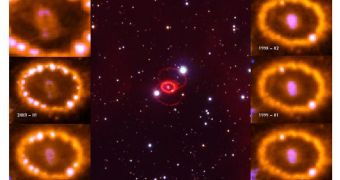For more than 10 years, astronomers have been observing the remnants of a supernova explosion, that took place nearby. Now, these studies are changing the way they understand the evolution of galaxies.
Supernova blasts are some of the most powerful events in the entire Universe. When they occur, they can briefly outshine entire galaxies.
These explosions only take place when massive stars, at least several times heavier than the Sun, reach the end of their burning cycle, having exhausted their supply of hydrogen.
This means that they can no longer sustain nuclear fusion. The cataclysmic reaction that ensues destroys the star by blowing up layers of its atmosphere, leaving only the core intact.
Using the Hubble Space Telescope, researchers looked at the remnants of the star SN1987A, which were first observed back in 1987. The data they collected were puzzling in nature.
The object can be found at the edge of the Tarantula Nebula, a stellar nursery in the nearby dwarf galaxy called the Large Magellanic Cloud (LMC).
Scientists have been conducting studies on this celestial body for more than a decade, and they are now beginning to discover clues as to how supernova blasts influence the development of their parent galaxies, Space reports.
The new investigation was led by University of Colorado in Boulder (UCB) research associate Kevin France, who is based at the Center for Astrophysics and Space Astronomy.
“These stars are so massive that they use their fuel very quickly. Our Sun lives for billions and billions of years because it's kind of a middle-weight star,” the expert explains.
In a study published in the September 3 issue of the esteemed journal Science, the expert and his team detail the interactions that develop between the circumstellar environment (the space around the former star) and the debris material caused by the supernova itself.
Experts determined that these interactions are increasing in intensity. This conclusion is based on the fact that hydrogen emissions detected in the interaction zones have been increasing in brightness for the past ten years.
“This brightening is telling us that more and more emission is being produced, and it's becoming more intense,” France says. He and his team peered over new Hubble data, and identified pearl-like structures within the supernova remnant, which are illuminated by the supernova itself.
“But, what it's really doing is telling us the amount of material that is crossing into the interaction zone where the blast wave is interacting with the circumstellar material,” he adds.
The research team also reveals that supernova blasts can easily produce incredible effects on the galaxies that contain them.
“They do produce so much energy that they tend to shape how a galaxy evolves over time. There aren't other processes in a typical galaxy that are as energetic as a supernova,” France reveals.
“If enough of these things happen, these could be the big players in determining how a galaxy evolves,” the team leader concludes.

 14 DAY TRIAL //
14 DAY TRIAL //